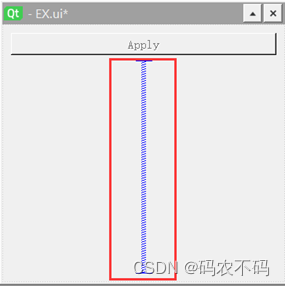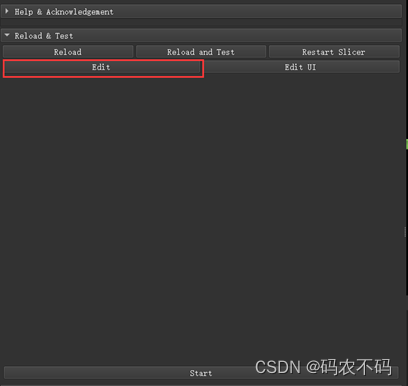前面已经介绍了创建扩展后的默认扩展程序,下面将修改这一扩展程序调用opencv库连接相机并在3Dslicer中显示出来。
首先点击扩展窗口中的Edit UI按钮,slicer会加载自带的Qt Designer工具。

在Qt Designer中删除不需要的控件,如下图红色方框所示。

此外还需要删除“弹簧”,去掉垂直间距。

在Qt Designer中搜索label控件,放入右侧界面中,并双击删除上面的文字“TextLabel”。

接下来,给窗体上的两个控件命名:

此外,我们给按键重新命名,如下图更改text:

至此,在Qt Designer中做的工作就完成了。
然后单击Edit打开pycharm编辑器。

** 默认程序中的测试类在此例程中未用到,可以直接删除;逻辑类在此例也未用到,可以做删除或隐藏。**
首先更改窗体类中的setup函数。将addObserver等不需要的程序删掉,只保留我们所需要的加载UI文件、设置mrml场景、设置控件槽函数(方便打开和关闭相机)功能等。修改后的代码如下:
def setup(self):
ScriptedLoadableModuleWidget.setup(self)
uiWidget = slicer.util.loadUI(self.resourcePath('UI/Camera.ui'))
self.layout.addWidget(uiWidget)
self.ui = slicer.util.childWidgetVariables(uiWidget)
uiWidget.setMRMLScene(slicer.mrmlScene)
self.logic = CameraLogic()
# Buttons
self.ui.applyButton.connect('clicked(bool)', self.onApplyButton)
self.initializeParameterNode()
self.ui.applyButton.enabled = True
然后在其他九个功能函数中删除我们不需要的功能(几乎全删)。前面提到,这些功能函数主要做了参数加载更新等操作,如果未全部删除重新加载的时候会报错。删完后的代码如下所示:
def cleanup(self):
pass
def enter(self):
self.initializeParameterNode()
def exit(self):
pass
def onSceneStartClose(self, caller, event):
self.setParameterNode(None)
def onSceneEndClose(self, caller, event):
if self.parent.isEntered:
self.initializeParameterNode()
def initializeParameterNode(self):
self.setParameterNode()
def setParameterNode(self):
self.updateGUIFromParameterNode()
def updateGUIFromParameterNode(self, caller=None, event=None):
pass
def updateParameterNodeFromGUI(self, caller=None, event=None):
if self._parameterNode is None or self._updatingGUIFromParameterNode:
return
wasModified = self._parameterNode.StartModify() # Modify all properties in a single batch
self._parameterNode.EndModify(wasModified)
此外我们需要在窗体类的初始化函数中初始化qt定时器和它的中断时间。
class CameraWidget(ScriptedLoadableModuleWidget, VTKObservationMixin):
def __init__(self, parent=None):
ScriptedLoadableModuleWidget.__init__(self, parent)
VTKObservationMixin.__init__(self) # needed for parameter node observation
self.logic = None
self._parameterNode = None
self._updatingGUIFromParameterNode = False
self.ui = None
self.timer = qt.QTimer()
self.timer.setInterval(20)
print("界面加载成功")
在按键槽函数中加入如下图所示代码,里面完成了三件事:①按键状态更新②定时器开启和中断③相机视频开启、设置和中断。定时器连接了一个槽函数,这是我们在其中创建一个新函数,用于读取视频数据并放入Label控件中显示。
def onApplyButton(self):
with slicer.util.tryWithErrorDisplay("Failed to compute results.", waitCursor=True):
# Compute output
if self.ui.applyButton.text =="Start":
self.ui.applyButton.text = "Stop"
self.timer.connect('timeout()', self.ImageShow)
self.timer.start()
self.cap = cv2.VideoCapture(0)
print("相机打开成功!")
self.cap.set(cv2.CAP_PROP_BUFFERSIZE, 3)
self.cap.set(cv2.CAP_PROP_FRAME_WIDTH, 1024)
self.cap.set(cv2.CAP_PROP_FRAME_HEIGHT, 768)
else:
self.ui.applyButton.text = "Start"
self.timer.stop()
self.cap.release()
print("关闭相机成功!")
上述定时器槽函数代码如下所示(新增加的函数):
def ImageShow(self):
try:
if self.cap.isOpened() != 1:
print("相机打开失败!")
return
print("相机运行中")
ret, img = self.cap.read()
showImg = cv2.resize(img,(640,480))
# QtImg = qt.QImage(showImg.data,qt.QImage.Format_RGB888)
# # QtImg = qt.QImage(showImg.data,showImg.shape[1],showImg.shape[0],showImg.shape[2]*showImg.shape[1],qt.QImage.Format_RGB888)
# self.ui.ImageShowLabel.clear()
# self.ui.ImageShowLabel.setPixmap(qt.QPixmap.fromImage(QtImg))
# 测试有效
cv2.imwrite("./Work/Camera/Camera/Resources/grab.jpg", showImg, [cv2.IMWRITE_PNG_BILEVEL, 0])
QtImg1 = qt.QPixmap("./Work/Camera/Camera/Resources/grab.jpg") # 从文件夹中获取图像有效
self.ui.ImageShowLabel.setPixmap(QtImg1)
# self.ui.ImageShowLabel.setPixmap(qt.QPixmap.fromImage(QtImg1))
except Exception as e:
print('%s' % e)
值得注意的是这里使用的显示视频的方法,在代码中注释调的一部分是pyqt一般的label组件显示视频流的方法,但是在这里试验起来不成功(后续会尝试其他方法),所以改成了注释下面的程序内容,即先将获取到的图像数据以png格式存储起来,在使用QPixmap获取图像数据,最后放入label组件中显示。
测试效果如下所示:

最后奉上完整程序。
import logging
import os
import ctk
import numpy as np
import vtk
import qt
import slicer
from slicer.ScriptedLoadableModule import *
from slicer.util import VTKObservationMixin
import cv2
#
# Camera
#
class Camera(ScriptedLoadableModule):
"""Uses ScriptedLoadableModule base class, available at:
https://github.com/Slicer/Slicer/blob/master/Base/Python/slicer/ScriptedLoadableModule.py
"""
def __init__(self, parent):
ScriptedLoadableModule.__init__(self, parent)
self.parent.title = "Camera" # TODO: make this more human readable by adding spaces
self.parent.categories = ["Examples"] # TODO: set categories (folders where the module shows up in the module selector)
self.parent.dependencies = [] # TODO: add here list of module names that this module requires
self.parent.contributors = ["John Doe (AnyWare Corp.)"] # TODO: replace with "Firstname Lastname (Organization)"
# TODO: update with short description of the module and a link to online module documentation
self.parent.helpText = """
This is an example of scripted loadable module bundled in an extension.
See more information in <a href="https://github.com/organization/projectname#Camera">module documentation</a>.
"""
# TODO: replace with organization, grant and thanks
self.parent.acknowledgementText = """
This file was originally developed by Jean-Christophe Fillion-Robin, Kitware Inc., Andras Lasso, PerkLab,
and Steve Pieper, Isomics, Inc. and was partially funded by NIH grant 3P41RR013218-12S1.
"""
# Additional initialization step after application startup is complete
slicer.app.connect("startupCompleted()", registerSampleData)
#
# Register sample data sets in Sample Data module
#
def registerSampleData():
"""
Add data sets to Sample Data module.
"""
# It is always recommended to provide sample data for users to make it easy to try the module,
# but if no sample data is available then this method (and associated startupCompeted signal connection) can be removed.
import SampleData
iconsPath = os.path.join(os.path.dirname(__file__), 'Resources/Icons')
# To ensure that the source code repository remains small (can be downloaded and installed quickly)
# it is recommended to store data sets that are larger than a few MB in a Github release.
# Camera1
SampleData.SampleDataLogic.registerCustomSampleDataSource(
# Category and sample name displayed in Sample Data module
category='Camera1',
sampleName='Camera1',
# Thumbnail should have size of approximately 260x280 pixels and stored in Resources/Icons folder.
# It can be created by Screen Capture module, "Capture all views" option enabled, "Number of images" set to "Single".
thumbnailFileName=os.path.join(iconsPath, 'Camera1.png'),
# Download URL and target file name
uris="https://github.com/Slicer/SlicerTestingData/releases/download/SHA256/998cb522173839c78657f4bc0ea907cea09fd04e44601f17c82ea27927937b95",
fileNames='Camera1.nrrd',
# Checksum to ensure file integrity. Can be computed by this command:
# import hashlib; print(hashlib.sha256(open(filename, "rb").read()).hexdigest())
checksums = 'SHA256:998cb522173839c78657f4bc0ea907cea09fd04e44601f17c82ea27927937b95',
# This node name will be used when the data set is loaded
nodeNames='Camera1'
)
# Camera2
SampleData.SampleDataLogic.registerCustomSampleDataSource(
# Category and sample name displayed in Sample Data module
category='Camera2',
sampleName='Camera2',
thumbnailFileName=os.path.join(iconsPath, 'Camera2.png'),
# Download URL and target file name
uris="https://github.com/Slicer/SlicerTestingData/releases/download/SHA256/1a64f3f422eb3d1c9b093d1a18da354b13bcf307907c66317e2463ee530b7a97",
fileNames='Camera2.nrrd',
checksums = 'SHA256:1a64f3f422eb3d1c9b093d1a18da354b13bcf307907c66317e2463ee530b7a97',
# This node name will be used when the data set is loaded
nodeNames='Camera2'
)
#
# CameraWidget
#
class CameraWidget(ScriptedLoadableModuleWidget, VTKObservationMixin):
def __init__(self, parent=None):
"""
Called when the user opens the module the first time and the widget is initialized.
"""
ScriptedLoadableModuleWidget.__init__(self, parent)
VTKObservationMixin.__init__(self) # needed for parameter node observation
self.logic = None
self._parameterNode = None
self._updatingGUIFromParameterNode = False
self.ui = None
self.timer = qt.QTimer()
self.timer.setInterval(20)
print("界面加载成功")
def setup(self):
ScriptedLoadableModuleWidget.setup(self)
uiWidget = slicer.util.loadUI(self.resourcePath('UI/Camera.ui'))
self.layout.addWidget(uiWidget)
self.ui = slicer.util.childWidgetVariables(uiWidget)
uiWidget.setMRMLScene(slicer.mrmlScene)
self.logic = CameraLogic()
# Buttons
self.ui.applyButton.connect('clicked(bool)', self.onApplyButton)
self.initializeParameterNode()
self.ui.applyButton.enabled = True
def cleanup(self):
pass
def enter(self):
self.initializeParameterNode()
def exit(self):
pass
def onSceneStartClose(self, caller, event):
self.setParameterNode(None)
def onSceneEndClose(self, caller, event):
if self.parent.isEntered:
self.initializeParameterNode()
def initializeParameterNode(self):
self.setParameterNode()
def setParameterNode(self):
self.updateGUIFromParameterNode()
def updateGUIFromParameterNode(self, caller=None, event=None):
pass
def updateParameterNodeFromGUI(self, caller=None, event=None):
if self._parameterNode is None or self._updatingGUIFromParameterNode:
return
wasModified = self._parameterNode.StartModify() # Modify all properties in a single batch
self._parameterNode.EndModify(wasModified)
def onApplyButton(self):
with slicer.util.tryWithErrorDisplay("Failed to compute results.", waitCursor=True):
# Compute output
if self.ui.applyButton.text =="Start":
self.ui.applyButton.text = "Stop"
self.timer.connect('timeout()', self.ImageShow)
self.timer.start()
self.cap = cv2.VideoCapture(0)
print("相机打开成功!")
self.cap.set(cv2.CAP_PROP_BUFFERSIZE, 3)
self.cap.set(cv2.CAP_PROP_FRAME_WIDTH, 1024)
self.cap.set(cv2.CAP_PROP_FRAME_HEIGHT, 768)
else:
self.ui.applyButton.text = "Start"
self.timer.stop()
self.cap.release()
print("关闭相机成功!")
def ImageShow(self):
try:
if self.cap.isOpened() != 1:
print("相机打开失败!")
return
print("相机运行中")
ret, img = self.cap.read()
showImg = cv2.resize(img,(640,480))
# QtImg = qt.QImage(showImg.data,qt.QImage.Format_RGB888)
# # QtImg = qt.QImage(showImg.data,showImg.shape[1],showImg.shape[0],showImg.shape[2]*showImg.shape[1],qt.QImage.Format_RGB888)
# self.ui.ImageShowLabel.clear()
# self.ui.ImageShowLabel.setPixmap(qt.QPixmap.fromImage(QtImg))
# 测试有效
cv2.imwrite("./Work/Camera/Camera/Resources/grab.jpg", showImg, [cv2.IMWRITE_PNG_BILEVEL, 0])
QtImg1 = qt.QPixmap("./Work/Camera/Camera/Resources/grab.jpg") # 从文件夹中获取图像有效
self.ui.ImageShowLabel.setPixmap(QtImg1)
# self.ui.ImageShowLabel.setPixmap(qt.QPixmap.fromImage(QtImg1))
except Exception as e:
print('%s' % e)
#
# CameraLogic
#
class CameraLogic(ScriptedLoadableModuleLogic):
def __init__(self):
ScriptedLoadableModuleLogic.__init__(self)
def setDefaultParameters(self):
print("no DefaultParameters")
def process(self):
print("non")
版权归原作者 码农不码 所有, 如有侵权,请联系我们删除。